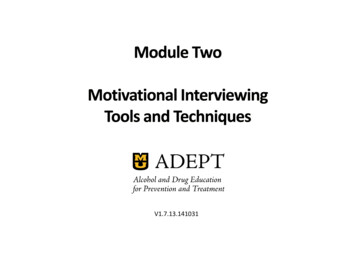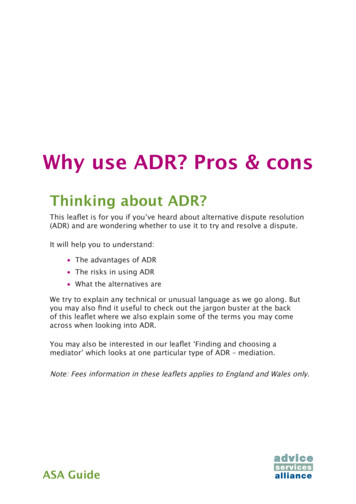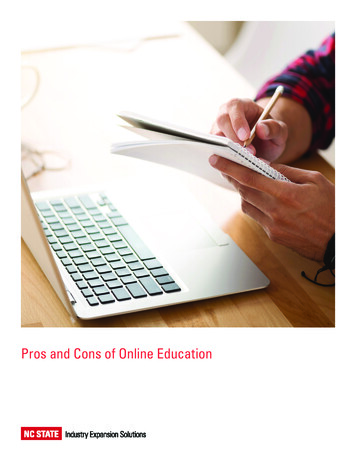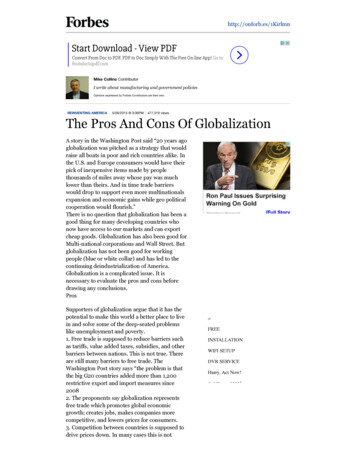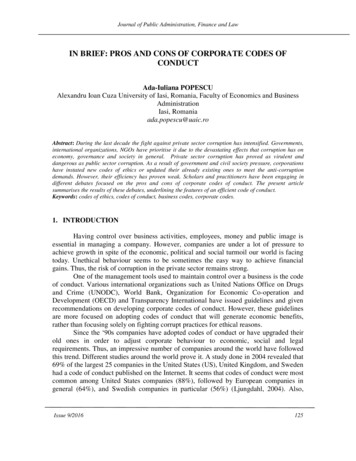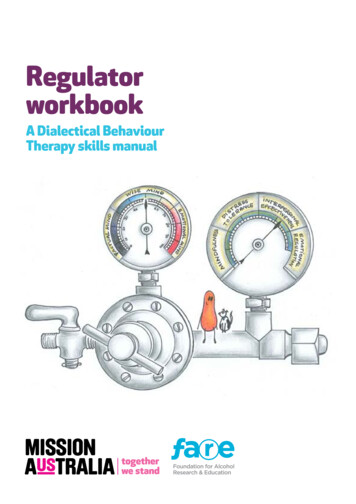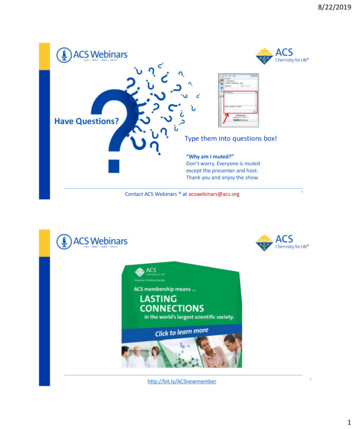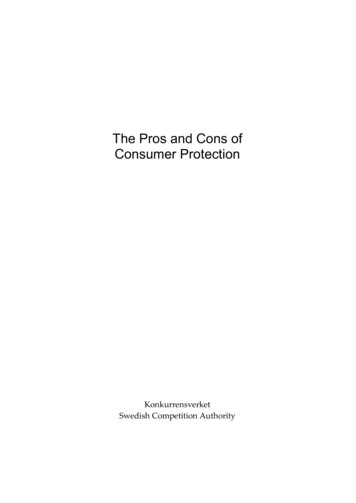
Transcription
The Pros and Cons ofConsumer ProtectionKonkurrensverketSwedish Competition Authority
2 2012 KonkurrensverketSwedish Competition AuthorityIndividual chapters 2012 The ContributorsISBN 978-91-88566-52-2Printed in Sweden byDavidsons Tryckeri AB, Växjö 2012
PrefaceThe conference ‚The Pros and Cons of Consumer Protection‛, heldin Stockholm November 11, was the tenth in the series of Pros andCons conference arranged by the Swedish Competition Authority.Leading experts from around the world brought differentperspectives to the theme and senior officials from competitionauthorities acted as discussants. This volume collects the five papersthat formed the base of an inspiring and well-attended conference.The lively debate and many appreciative comments I heard at theconference is testimony of the high professional standard of thecontributions and of their relevance and timeliness for competitionand consumer policy.I would like to express my sincere gratitude to all contributingauthors, to the discussants and to the moderator of the conference,Bill Kovacic. I would also like to thank those at the SwedishCompetition Authority who have worked with the project, StenNyberg who managed the project and acted as editor, Saba Zarrani,who assisted with the organization of the conference and KristinaEvensen who assisted in producing this conference volume.Stockholm, March 2012Dan SjöblomDirector General
4Table of contentsThe speakers . 51.Introduction . 8By Sten Nyberg2.Competition and Consumer Protection: A BehavioralEconomics Account . 12By Oren Bar-Gill3.Deception and Consumer Protection in Competitivemarkets . 44By Paul Heidhues, Botond Köszegi and Takeshi Murooka4.Behavioral Exploitation and its Implications on Competitionand Consumer Protection Policies . 77By Maurice E. Stucke5.Economic Models of Consumer Protection Policies . 123By Mark Armstrong6.What role does Economics have to play in ContingentCharges Regulations? . 148By Matthew Bennett
5The speakersOren Bar-Gill is a Professor of Law and Co-Director of the Centerfor Law, Economics and Organization at the New York UniversitySchool Of Law. His scholarship focuses on the law and economics ofcontracts and contracting. Bar-Gill's publications include: "Consentand Exchange" (with Lucian Bebchuk), which appeared in theJournal of Legal Studies (2010); "The Law, Economics, andPsychology of Subprime Mortgage Contracts," which appeared in theCornell Law Review (2009); "The Prisoners' (Plea Bargain) Dilemma"(with Omri Ben-Shahar), which appeared in the Journal of LegalAnalysis (2009); "Making Credit Safer" (with Elizabeth Warren),which appeared in the University of Pennsylvania Law Review(2008); "Bundling and Consumer Misperception," which appeared inthe University of Chicago Law Review (2006); "Credible Coercion"(with Omri Ben-Shahar), which appeared in the Texas Law Review(2005); "Seduction by Plastic," which appeared in the NorthwesternUniversity Law Review (2004); and "The Law of Duress and theEconomics of Credible Threats" (with Omri Ben-Shahar), whichappeared in the Journal of Legal Studies (2004).Bar-Gill's recent work focuses on consumer contracts. In 2011,Bar-Gill was awarded the prestigious Young Scholar Medal by theAmerican Law Institute, in recognition of his work on consumercontracts.Bar-Gill joined the New York University School of Law faculty inJanuary 2005 from Harvard University, where he was a Fellow at theSociety of Fellows, as well as an Olin Fellow at Harvard Law School.Bar-Gill holds a B.A. (economics), LL.B., M.A. (law & economics) andPh.D. (economics) from Tel-Aviv University, as well as an LL.M. andS.J.D. from Harvard Law School. Bar-Gill served in the Israeli JAG,from 1997-1999, where he participated in criminal, administrativeand constitutional proceedings before various courts including theIsraeli Supreme Court and the IDF Court of Appeals.
6Paul Heidhues is Full Professor and Lufthansa Chair inCompetition and Regulation at ESMT in Berlin, Germany. He hasreceived his PhD from Rice University in 2000, and previously heldpositions as a Research Fellow at the WZB (Berlin), AssociateProfessor for Economic Theory at Bonn University, as well as visitingpositions at University of California-Berkeley, University ofPittsburgh, and Massachusetts Institute of Technology. He hasworked on various topics in Industrial Organization andCompetition Policy such as input-market bargaining power, mergercontrol, and collusion. Recently, much of his work focuses on thefunctioning of markets when consumer are partly driven bypsychological factors – such as social preferences, loss aversion, timeinconsistency, or naivete – that the classic consumer model abstractsfrom.Professor Stucke brought 13 years of litigation experience whenhe joined the University of Tennessee College of Law faculty in 2007.As a trial attorney at the U.S. Department of Justice, AntitrustDivision, he successfully challenged anticompetitive mergers andrestraints in numerous industries, and focused on policy issuesinvolving antitrust and the media. As a Special Assistant U.S.Attorney, he prosecuted various felonies and misdemeanors. As anassociate at the law firm Sullivan & Cromwell, Professor Stuckeassisted in defending Goldman Sachs, CS First Boston, and Microsoftin civil antitrust litigation, and was presented two awards by TheLegal Aid Society for his criminal appellate and defense work.Professor Stucke is currently a Senior Fellow at the AmericanAntitrust Institute; he chaired a committee on the media industrythat drafted a transition report for the incoming Obamaadministration. In 2009, Professor Stucke was elected as a member tothe Academic Society for Competition Law (ASCOLA), appointed tothe advisory board of the Institute for Consumer Antitrust Studies,and was asked to serve as one of the United States' nongovernmental advisors to the International Competition Network.In 2010, Prof. Stucke lectured as a Fulbright Scholar in thePeople's Republic of China. His article, "Behavioral Economists at the
7Gate: Antitrust in the Twenty-First Century," received the 2007 JerryS. Cohen Memorial Fund Writing Award for the best antitrust article.His scholarship has been cited by the OECD, competition agencies,and policymakers.Mark Armstrong is Professor of Economics and Fellow of AllSouls College at the University of Oxford. He is a Fellow of theEconometric Society and of the British Academy. He is currently aneditor at the Rand Journal of Economics. He has published broadlyin the areas of industrial organization and the economics ofincentives, with a particular focus on regulation, competition andconsumer policy, price discrimination, and consumer search.Dr. Matthew Bennett is the Director of Economics at the Office ofFair Trading. Matthew is responsible for the Economic Policy,Financial Analysis, Statistics and Econometric teams within the OFT.This responsibility includes supervising the economic review of OFTcases, commissioning economic research and developing the OFT'seconomic approach to competition and consumer policy. He hasbeen active on both the consumer side (including cases in Banks andGyms) and the competition side (including several ongoing ChapterI and II investigations).Matthew joined the OFT from LECG where he was a Principaldirecting competition cases. Cases that he worked on during thistime include the Aer Lingus / Ryan Air merger, Microsoft, FrenchMobiles and Bananas. Prior to this he worked for the UKCommunications Regulator OFCOM within the Chief Economist'steam. Matthew gained his Economics doctorate at WarwickUniversity and completed a Post-Doctorate in Toulouse, where hestudied the interaction between competition and regulation. He haspublished a number of papers in the area of competition andconsumer policy, most recently on the law and economics of RPMand Information Exchange.
81IntroductionBy Sten NybergConsumer welfare is a central objective for both consumer protectionand competition policy where the former targets the consumer andthe latter market performance. These policy areas complement eachother but the difference in approach can also result in conflictingpolicies, and a need for coordination. The conference The Pros &Cons of Consumer Protection, focused on consumer protection,competition policy and the implications of recent developments inbehavioral economics, as well as analyses based on informationeconomics, for these policy areas.Oren Bar-Gill from New York University discusses whether thebenefits of competition that obtain in a world of rational consumersalso extend to world with imperfectly rational consumers. He arguesthat sellers will adapt their behavior and may exploit consumermisperceptions and that the circumstances under which firms haveincentives to educate consumers are rather limited. In fact,competition may in some cases actually work to exacerbateconsumer misperceptions. Firms, may for instance increase thecomplexity of their pricing schemes to make comparisons moredifficult. An important policy tool for addressing behavioral marketfailures of this type is a well designed disclosure regulation. Policiesmandating disclosure of information, including information abouthow consumers use the product, may improve welfare. Bar-Gilldiscusses both simple disclosure policies targeting consumers as wellas more complex disclosure policies aimed at intermediaries.Paul Heidhues, of the European School of Management andTechnology, presented joint work with Botond Köszegi and TakeshiMurooka on consumer misperception and deception in competitivecredit markets. The authors cite ample evidence on consumermisperceptions in financial markets, including home mortgage,
9insurance and retail banking. They proceed to discuss how firmsmay set fees to exploit consumer misperceptions about their ownbehavior, or the features of the contracts they are facing, and notethat competition in many cases does not ‚provide safety in markets‛.Firms may have insufficient incentives to disclose, or unshroud, thetrue costs of contracts, which is more likely to be the case inconcentrated markets. Moreover, while competition for boundedlyrational customers’ patronage may drive firms to offer up-frontpayments compensating these consumers for the ex-postexploitation, the authors argue that in many financial consumermarkets the scope for such payments may be severely limited by thepresence of ‚arbitrageurs‛, who are interested in up-front paymentsbut perhaps not in using the service. It then also follows that theargument that the cost of consumer protection policies ultimatelywill be passed on to consumers does not hold up. Consequently,consumer protection policies may have an important role to play inimproving consumer welfare. That said, there are several pitfalls andpolices need to be assessed on a case-by-case basis.That competition and consumer protection policies areinterrelated is also emphasized by Maurice Stucke, from theUniversity of Tennessee, who discusses the implications of boundedrationality and imperfect willpower on the part of consumers for ourconception of competition, its effect on consumers, and ultimately forthe role of consumer protection and competition policy. Stucke alsoconsiders bounded rationality on the part of firms and thegovernment but focuses on the case where firms are relatively morerational than consumers. While boundedly rational consumers canbe subject to behavioral exploitation in competitive markets, suchmarkets can also provide remedies for behavioral consumer biases,such as commitment devices for time-inconsistent consumers. Stuckeargues that competition and consumer protection policies canimprove consumer welfare but should not be viewed in isolation.The former serve to promote variety and informed consumer choicesand the latter to prevent behavioral exploitation. Too far reachingintervention risks to limit behavioral freedom, lead to creeping
10authoritarianism and learned helplessness. Moreover, policyinterventions require that authorities, that may be boundedlyrational themselves, can identify the problems and should also factorin the value of the consumers’ freedom to choose.Mark Armstrong from Oxford University discusses informationbased models of consumer protection without behavioral biases.Consumers may search for information about price and productfeatures themselves or rely on information provided by the market,e.g. by sellers. In the former case, certain sales tactics may harmconsumers. Armstrong discusses the effects of consumer protectionpolicies in three types of contexts; consumer search markets, rusheddecision making and commission based sales. In the first case,consumer protection policies that aim to protect less informedconsumers against high prices may have the perverse effect ofraising market prices on average. The reason is that the policyreduces consumers’ search intensity, which softens competitionamong firms. Armstrong shows that rushed sales tactics can lead toboth higher prices and poor matches between buyers and sellers andthus consumer protection policies, such as mandated cooling offperiods can be welfare improving. Finally, commissions tointermediaries advicing consumers about product choice may welllead to higher prices which may motivate policies restricting suchcommissions.Designing policy interventions to protect consumers is oftendifficult and contingent on the characteristics of the specific market.Also, as Matthew Bennett from the Office of Fair Trading points out,markets can be self-correcting. Consumers may learn, markets selfregulate, and other parties could profit from correcting the problem.In addition, policy intervention may itself be distortive. It is thereforeuseful to establish sound economic principles to help determine, in asystematic way, whether a policy intervention has merit. Bennettexamines these issues in the context of assessing the effects ofcontingent charges, such as overdraft fees, and outlines foureconomic principles for such an assessment: Whether consumerswitching in the primary, or secondary, market constrain firms,
11whether the charges are harmful for consumers and whether thereare consumer benefits potentially outweighing the harm. While theprinciples could be interpreted as consistent with the letter of theapplicable UK legislation, a recent precedent seems to provide littlescope for legal action against contingent charges.Taken together these contributions provides a broad overview ofcurrent research in law and economics with bearing on consumerprotection. The conference also greatly benefited from manyinsightful comments from the discussants as well as from theaudience. Some of the discussants’ comments are available at theSwedish Competition Authority’s web page, www.konkurrensverket.se.
122Competition and Consumer Protection:Behavioral Economics AccountBy Oren Bar-Gill2.1 IntroductionIt is widely believed that competition among sellers ensuresefficiency and maximizes welfare. This belief is manifested, forexample, in antitrust law and its focus on monopolists and cartels. Inaddition, competition is supposed to help consumers by keepingprices low. Do these benefits of competition extend to a world – thereal world – with imperfectly rational consumers?The answer to this question, I argue, should follow from a twostage analysis. The first stage of the analysis takes consumermisperception, concerning product benefits and prices, as given orexogenous. The second stage of the analysis allows for endogenousperceptions and misperceptions. This chapter draws on material from my forthcoming book on the Law,Economics and Psychology of Consumer Contracts. I thank Declan Purcellfor the insightful comments that he provided, when discussing a previousversion of this chapter at the Pros & Cons of Consumer Protectionconference. I also thank Omri Ben-Shahar and Ariel Porat for helpfulcomments. The financial support of the Filomen D'Agostino and Max E.Greenberg Research Fund at NYU School of Law is gratefullyacknowledged. that he provided, when discussing a previous version of thischapter at the Pros & Cons of Consumer Protection conference. I also thankOmri Ben-Shahar and Ariel Porat for helpful comments. The financialsupport of the Filomen D'Agostino and Max E. Greenberg Research Fund atNYU School of Law is gratefully acknowledged.
13The first stage of the analysis is conducted in Section 3.2.2. Underthe exogenous misperceptions assumption, competition fails topromote efficiency and to protect consumers. The reason isstraightforward: Competition forces sellers to maximize theperceived (net) consumer benefit. When consumers accuratelyperceive the (net) benefit, competition will help consumers. Butwhen consumers are biased, competition will maximize theperceived (net) benefit at the expense of the actual (net) benefit.Focusing on price: When consumers are rational, sellers compete byoffering a lower price. When consumers are imperfectly rational,sellers compete by designing pricing schemes that create anappearance of a lower price. The underlying problem is located atthe demand side of the market – imperfectly rational consumersgenerate biased demand. Competition forces sellers to cater to thisbiased demand. The result is what I call a behavioral market failure.Modern, neoclassical economics recognizes that even perfectlycompetitive markets can fail. The standard market failures areattributed to externalities and to asymmetric information. Behavioraleconomics adds a third market failure. The behavioral marketfailure, with its emphasis on misperception and bias, is a directextension of the imperfect information problem. Rational consumersform unbiased estimates of imperfectly known values. Faced withsimilarly limited information, imperfectly rational consumers formbiased estimates. Unbiased estimates can cause market failure.Biased estimates can cause a more severe market failure.With exogenous consumer misperception, competition does nothelp. But does it hurt? A monopolist can similarly be expected todesign products, contracts and pricing schemes to maximize theperceived (net) benefit from its products. But a monopolist may alsodecide to take the high road and offer good products, rather thanproducts that look good to the biased consumer. In a competitivemarket, sellers have no choice but to target product design to thepsychology of consumers. A high-road seller who offers what sheknows to be the best product will lose business to the low-road sellerwho offers what the consumer mistakenly believes to be the best
14product. Put bluntly, competition forces sellers to exploit the biasesand misperceptions of their customers.The first stage of the analysis takes consumer misperception asgiven and argues that competition does not help in this context. InSection 2.3, I turn to the second stage of the analysis and endogenizemisperception. Consumer perceptions and misperceptions are notfixed. They evolve over time. Most importantly, for presentpurposes, sellers in a competitive market invest in influencingconsumer perception. In some cases, competition will induce sellersto correct consumer mistakes, thus enhancing efficiency andincreasing consumer surplus. Unfortunately, there are limits to thesemistake-correction forces. Competition will not always work toreduce consumer misperception, and, in certain cases, it might evenwork to exacerbate misperception.Section 2.4 briefly addresses the welfare implications of thepreceding behavioral economics analysis. In particular, I note thatsellers, when facing imperfectly rational consumers, can be expectedto artificially increase the complexity of their products, contracts andpricing schemes. This increased complexity raises the costs ofcomparison-shopping and thus hinders competition. The behavioralmarket failure weakens the forces of competition. It also distorts theremaining, weakened forces of competition. As explained above,competition will work to maximize perceived (net) benefits, ratherthan actual (net) benefits. This means that sellers will reduce salientprices and compensate by increasing non-salient prices. Pricing thatis salience-based, rather than cost-based, results in skewed incentives– for product choice and for product use.Section 2.5 turns to policy, focusing on the potential to enhancecompetition, and protect consumers, through better-designeddisclosure regulation – disclosure regulation that directly respondsto the imperfect rationality problem. As a preliminary matter, I notethat the object of disclosure mandates should be broadened. Whileexisting disclosure mandates largely focus on product attributeinformation, I argue that more attention should be given to the
15disclosure of product use information – information on how theproduct will be used by the consumer.The imperfect rationality of consumers suggests that, to beeffective, disclosure regulation must adopt one of the following twostrategies. The first focuses on simple disclosures targetingconsumers. The idea is to design aggregate, one-dimensionaldisclosures that would facilitate comparison between competingproducts. The second strategy reconceptualizes disclosure as aimednot at imperfectly rational consumers, but at sophisticatedintermediaries. Accordingly, this disclosure could be morecomprehensive, and more complex.Before proceeding further, an important qualification is in order:The behavioral economics model, even more than its rational choicecounterpart, is context dependent. While the analysis and discussionbelow are often stated in general terms, implementation must bemarket specific. The severity of the behavioral market failure, andthe ability of competition to mitigate the welfare costs of thebehavioral market failure, will vary from market to market. Theviability of the proposed approach to disclosure regulation willsimilarly vary from market to market, as will the optimal design ofthe disclosure regime. This chapter focuses on general themes,leaving the important market-specific analysis to other work. (See,e.g., Bar-Gill, 2004; Bar-Gill, 2009; Bar-Gill and Stone, 2009.)2.2Exogenous MisperceptionsIn this Section, I take consumer misperception as given, andstudy the effects of misperception on market outcomes. The basicclaim is that sellers operating in a competitive market will designtheir products and pricing schemes in response to consumermisperception – to the detriment of consumers. Market forcesdemand that sellers be attentive to consumer psychology. Sellers thatignore consumer biases and misperceptions will lose business andforfeit revenue and profits. Over time, sellers that remain in the
16market, profitably, will likely have adopted product features andpricing schemes that optimally respond to the psychology of theircustomers.A. Framework of AnalysisIt is useful to start by reciting the standard, rational choiceframework. This standard framework will then be adjusted to allowfor the introduction of consumer biases and misperceptions.Juxtaposing the standard and behavioral frameworks will helpcompare market outcomes under the two models.In the rational choice framework, a consumer product provides) in exchange for a set ofthe consumer with a set of benefits (), while imposing on the seller a set of costsprices ((). It is useful to think about the total expected benefit(), the total expected price (), and the total). The number of units sold, which will beexpected cost (referred to as the demand for a seller's product, D, is increasing inthe benefit that the product provides, B, and decreasing in the price),that the seller charges, P. The demand function is, therefore, (withandThe seller's revenue, R, is given by thenumber of units sold, i.e., the demand for the product, multiplied by)() . And the seller's profit, , isthe price per unit: ()()()equal to revenue minus cost: (() ().When consumers are imperfectly rational, suffering from biasesand misperceptions, this general framework must be extended as), there arefollows: In addition to the actual benefits (perceived benefits ( ̂ ̂), which are potentially different fromthe actual benefits. And there is a perceived total expected benefit̂(̂ ̂), which is potentially different from the actual total). Similarly, in addition to the actualexpected benefit (), there are perceived prices ( ̂ ̂), which areprices (potentially different from the actual prices. And there is a perceived
17), which is potentially different fromtotal expected price ̂ ( ̂ ̂). Demand is now athe actual total expected price (function of perceived benefits and prices, rather than of actualbenefits and prices: ( ̂ ̂ ), withandRevenues are â̂function both of perceived benefits and prices and of the actual price:(̂ ̂ )( ̂ ̂ ) . And so are profits:(̂ ̂)).(̂ ̂ )( ̂ ̂)( ̂ ̂) (Before proceeding further, the relationship between imperfectinformation and imperfect rationality should be clarified. Rationalchoice theory allows for imperfect information. A divergencebetween perceived benefits and prices, on the one hand, and actualbenefits and prices, on the other hand, is possible also in a rationalchoice framework with imperfectly informed consumers. The focushere, however, is on systemic under- and overestimation of benefitsand prices. Perfectly rational consumers will not have systemicallybiased beliefs. Imperfectly rational consumers will. The maindifference between the rational and imperfectly rational consumer isin how they deal with imperfect information. Rational-choicedecisionmaking provides tools for effectively coping with imperfectinformation. These tools are not available to the imperfectly rationalconsumer. Instead, he uses heuristics or cognitive rules-of-thumb,which result in predictable, systemic biases and misperceptions.1Sellers strive to maximize profits. To maximize profits sellersmust keep costs down and revenues up. Revenues are the product ofthe number of units sold, or the demand for the product, multipliedby the price per unit. These observations imply two tradeoffs thatdetermine the seller's strategy in a rational choice framework: First,the seller wants to increase the benefits from the product, in order to1Moreover, while the perfectly rational consumer realizes that she isimperfectly informed, the imperfectly rational consumer might be blissfullyunaware of the extent of his ignorance.
18increase demand, but increased benefits usually entail increasedcosts. The seller will increase the benefits, as long as the resultingrevenue boost more than compensates for the increased costs. Thesecond tradeoff focuses on the price: a lower price increases thenumber of units sold, i.e., increases demand, but also decreases therevenue per unit sold. The seller will set prices that optimallybalance these two effects.2The tradeoffs that determine a seller's optimal strategy, whenfacing rational consumers, are muted in the behavioral economicsmodel with imperfectly rational consumers. When perceived benefitis different from actual benefit, a seller may be able to increasedemand by raising the perceived benefit, without incurring theadded cost of raising the actual benefit. Similarly, when theperceived price is different from the actual price, demand can beincreased by lowering the perceived price, while keeping revenueper unit up with a high actual price. Sellers benefit from thedivergence between perceived and actual benefits and betweenperceived and actual prices. They will design their products andprices to maximize this divergence.A brief note on the objects of misperception: Consumers mightmisperceive the total benefit from a product and the total price of theproduct. It is useful, however, to break things down a bit. Inparticular, it is useful to distinguish between two categories ofinformation and corresponding misperceptions:(1) Product attribute information and product attributemistakes – information/mistakes about what the product is2In addition, certain price dimensions affect how the consumer will use theproduct and thus the benefit that the consumer derives from the product.These effects also influence the optimal design of products, contracts andprices, as illustrated in subsection B below.
19or does, including information/mistakes about themagnitude of different price dimensions.(2) Product use information and product use mistakes –information/mistakes about how the consumer will use theproduct or a certain product feature. Clearly, how a productis used will be a function of the product’s attributes, but itwill also be a function of consumer preferences and otherexternal forces.As explained below, this distinction between product attributesand use patterns will prove important in evaluating the efficacy ofmistake-correction forces (in Section 2.3). It will also be relevant forthe policy implications discussed in Section 2.5.B. A Simple ExampleIn this subsection, I develop a simple example that illustrateshow sellers, operating in a competitive market, adjust their pricingstrategies in response to consumer misperception. The skewedpricing will be shown to reduce welfare and hurt consumers.1. Benefits, Costs and PricesConsider a credit card contract with two features: (1) a generalfeature(s) that may include the convenience of holding the card,access to customer service, etc’, and (2) a late payment feature. Aconsumer obtains an annual benefitfrom the generalfeature(s). This benefit is enjoye
The conference ‚The Pros and Cons of Consumer Protection‛, held in Stockholm November 11, was the tenth in the series of Pros and Cons conference arranged by the Swedish Competition Authority. Leading experts from around the world brought different perspectives to the theme and senior officials from competition


